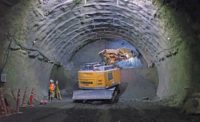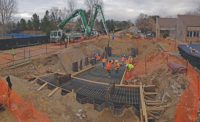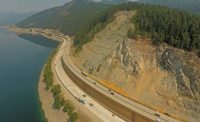Mud Mountain Dam 9-Ft Tunnel Re-armoring
Enumclaw, Wash.
Project of the Year Finalist and Best Project
Owner: U.S. Army Corps of Engineers, Seattle District
Lead Design Firm/Structural Engineer/Civil Engineer: ILF Consultants Inc.
General Contractor: Garney Federal Inc.
Hydraulic Consultant: Golder Associates
Subcontractors: Streich Bros. Inc.; Hunnicutt’s Inc.; Associated Underwater Services
For nearly 80 years, tens of thousands of tons of sediment, ranging from fine sand particles to 20-in.-dia boulders, have passed through the 1,900-ft long tunnel, gradually eroding its 1-in.-thick steel floor liner. Rather than simply replacing the liner with new steel, the project team proposed installing a system of granite blocks that would be less expensive to construct, dramatically improve the service life of the liner and reduce long-term maintenance needs.
With only one other tunnel in the world using this approach, the team conducted site-specific modeling to analyze flow dynamics under a variety of conditions. The data helped to establish substrate permeability requirements and material specifications and to fine-tune drainage components, such as incorporating synthetic wick drains to maintain the system’s low vertical profile.
After filling scour holes with concrete and steel reinforcing, crews placed the 1,300-lb, precision-cut, 3-ft by 3-ft by 10-in. granite blocks with the assistance of a small hydraulic electric lift and pneumatic suction head, thus reducing the potential for injuries from lifting the heavy blocks. A 4-in. layer of pervious concrete on the tunnel floor provided a stable, flat surface for laying the blocks and allowed water to flow freely under the granite. All blocks were premanufactured with surfaces shaped to match specific locations in the tunnel.
Along with adopting innovative measures to control the near-constant water intrusion that interfered with work tasks, the contractor implemented a variety of safety measures tailored to the unique work environment. An air-monitoring system ensured that natural air flow was sufficient to maintain safe breathing levels, and all equipment was powered by electricity, batteries or propane to mitigate potential air contamination.
The team developed a medical evacuation plan to address the possibility of removing an injured worker from any location in the tunnel. Sign-in/sign-out procedures ensured that no workers were left behind at the end of a shift. The 38-month project was completed ahead of schedule and under budget.





